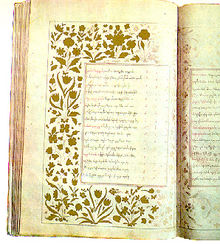Culture of old Georgia
The Georgian alphabet was invented in the 5th century BC and reformed by King Parnavaz I of Iberia in 284 BC.
Georgia's medieval culture was greatly influenced by Orthodox Christianity and the Georgian Orthodox and Apostolic Church, which promoted and often sponsored the creation of many works of religious devotion. These included churches and monasteries, works of art such as icons, and hagiographies of Georgian saints. As well as this, many secular works of national history, mythology and hagiograpy were also written.
Ecclesiastical art

Medieval Georgian icons are renowned as being among the finest creations of Orthodox religious art. Notable examples include:
- The Icon of 886 from Zarzma
- The Icon of the 9th century from Tsilkani
- The famous "Wonderworking Iberian Icon of the Mother of God" (10th century)
- The Icon of the 10th century from Okona
- The Icon of Our Lady of Khakhuli of the 12th century
- The Icon of St. George of the 11th century from Labechina
- The Icon of St.George of the 11th century from Nakipari
- The Icon of the 12th century from Anchiskhati
- The Icon of the 14th century from Ubisa
- The Icon of the 16th century from Alaverdi
Ecclesiastical monuments
Well-known monuments of Georgian Christian architecture include:
- The Georgian Church in Bethlehem (4th century)
- The Church of Gavazi (4th century) in Akhalsopeli (Kvareli district of Kakheti region)
- Akaurta Church (5th century) in Bolnisi district (Kvemo Kartli region)
- Ikalto Monastery complex (5th-7th centuries) (Kakheti)

- Sioni church (5th century) in Bolnisi
- Monastery of Shio Mghvime (6th century)
- Davidgareja Monastery complex (6th-7th centuries)
- Jvari Monastery in Mtskheta (6th century)
- Anchiskhati Church (6th century) in Tbilisi
- Nekresi Monastery Complex (4th-9th centuries) in Kakheti
- Sioni church (7th century) in Ateni
- Petritsoni Monastery in Bulgaria (11th century)
- The Georgian Monastery (10th century) on the Black Mountain in Syria
- The Georgian Iveron Monastery on Athos (10th century)
- Svetitskhoveli Cathedral in Mtskheta (10th century)
- Opiza Monastery (10th century) in Tao-Klarjeti (now territory of Turkey)
- Monastery Doliskana (10th century) in Tao-Klarjeti (now territory of Turkey)
- Monastery Otkhta-Eklesia in Tao-Klarjeti (now territory of Turkey)
- Oshki Monastery (10th century) in Tao-Klarjeti (now territory of Turkey)
- Gelati Monastery (11th century) in Kutaisi
- Sioni Cathedral (11th century) in Tbilisi
- Alaverdi church (11th century) in Kakheti
- Monastery Samtavro (12th century) in Mtskheta
- Vardzia Monastery (12th century) in Meskheti
Well-known Georgian painters were: Damiane (13th century), Anania (15th century), Mamuka Tavakarashvili (17th century), etc.
The works of the famous Georgian goldsmiths, Beka and Beshken Opizari (11th century), are an outstanding contribution to world art.
Literary and other written works

Important Georgian literary works of the pre-Christian period are:
- Amiraniani, ancient Georgian folk epos of the end of the 2nd millennium BC
- Life of the King Farnavaz (anon) (3rd century BC)
Notable Georgian written works from the medieval period include:
- The Life of Saint Nino (4th century) (anon)
- The Life of the King Mirian by Abyatar (4th century)
- The Martyrdom of Queen Shushanik by Iakob Tsurtaveli (5th century)
- Corpus Areopagiticum, a philosophical and theological work attributed by some to Peter the Iberian (5th century)
- The Martyrdom of Abo Tbileli by Ioane Sabanisdze (8th century)
- The Life of Grigol Khandzteli by Giorgi Merchule (10th century)
- Ustsoro Karabadini (Peerless Karabadini) 10th century
- A History of the Georgian Kings ("Tskhovreba Kartvelta Mepeta") by Leonti Mroveli (11th century)
- A History of the Royal House of Bagrationi by Sumbat Davitisdze (11th century)
- Tamariani by Ioane Chakhrukhadze (12th century)
- Shen Khar Venakhi ("Thou Art a Vineyard"), the famous Georgian religious hymn by the King Demetre I Bagrationi (12th century)
- Vepkhistkaosani (The Knight in the Panther's Skin), a national epic poem by Shota Rustaveli (12th century)
- Abdulmesiani by Ioane Shavteli (13th century)
- Kartlis Tskhovreba (History of Georgia), a collection of old Georgian chronicles (from ancient times to the 14th century)